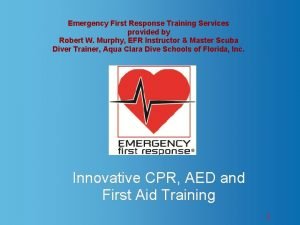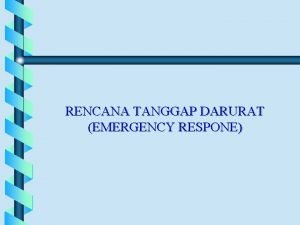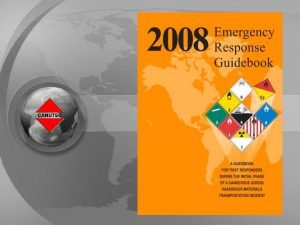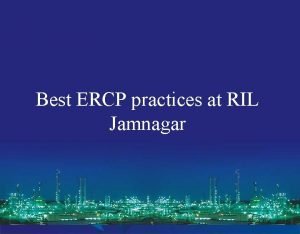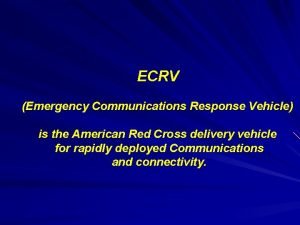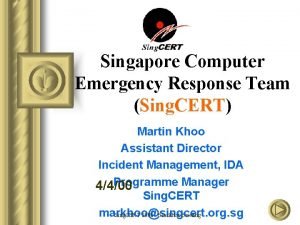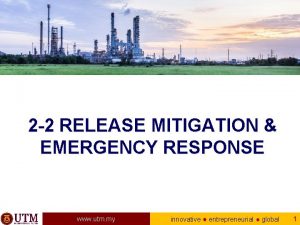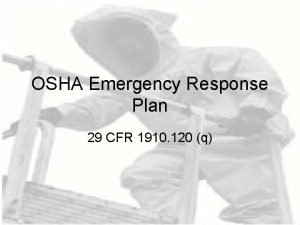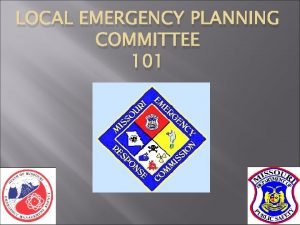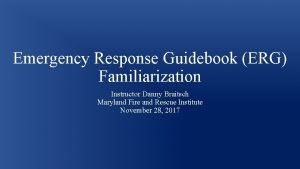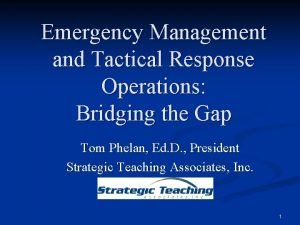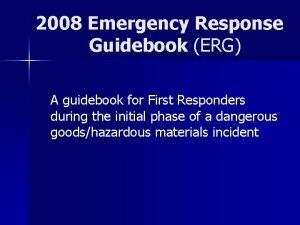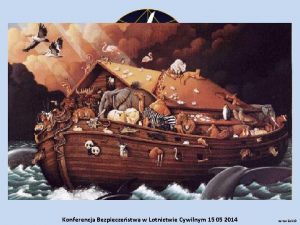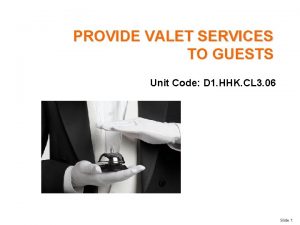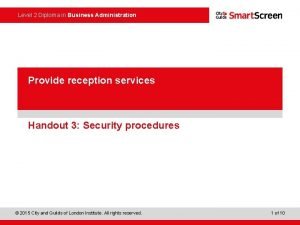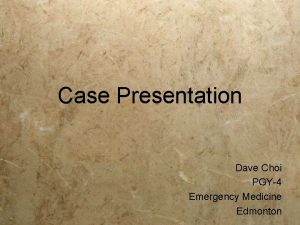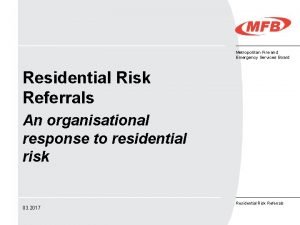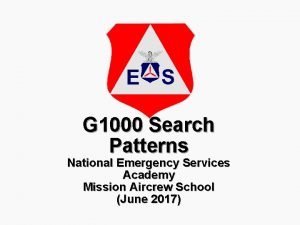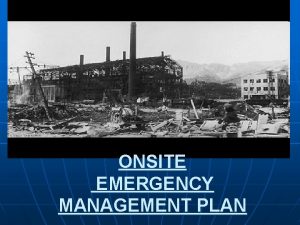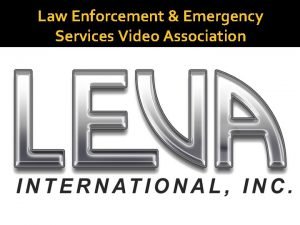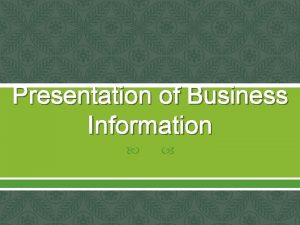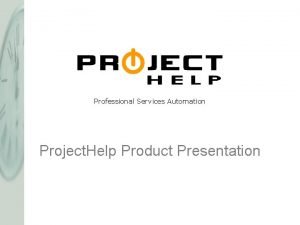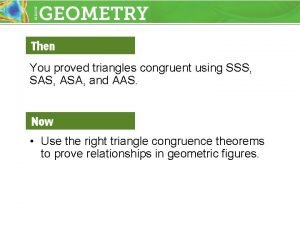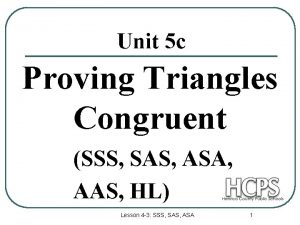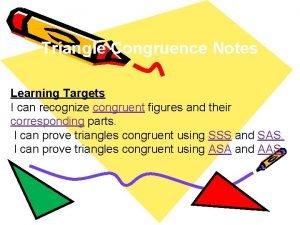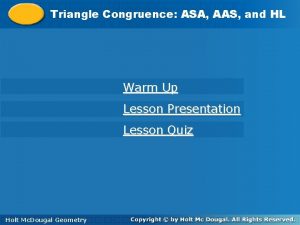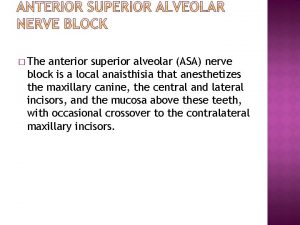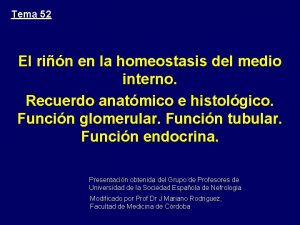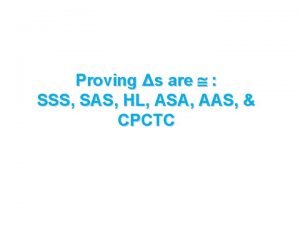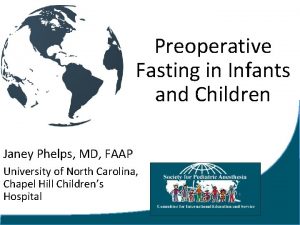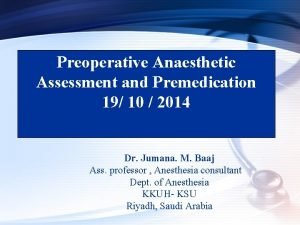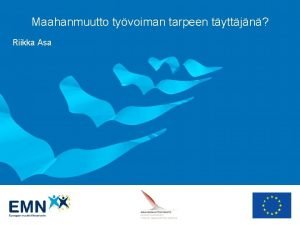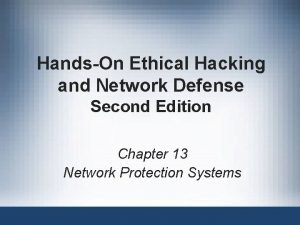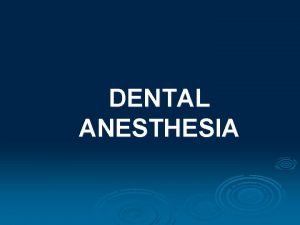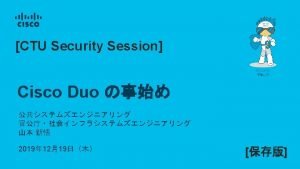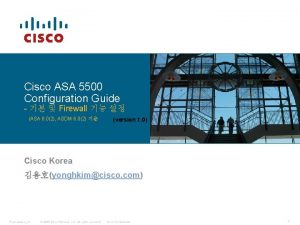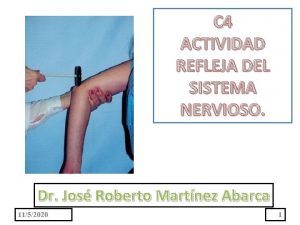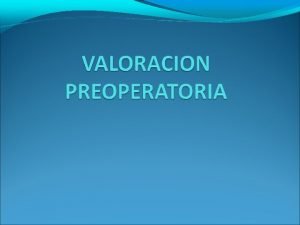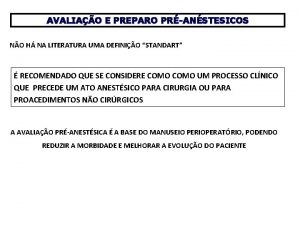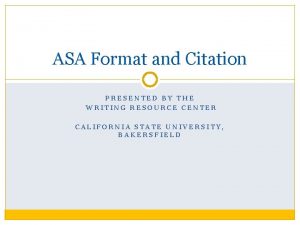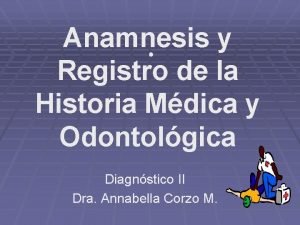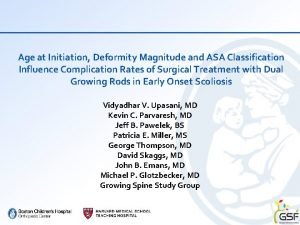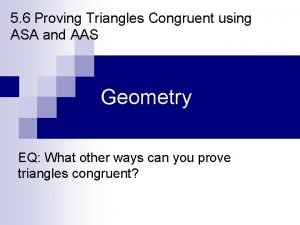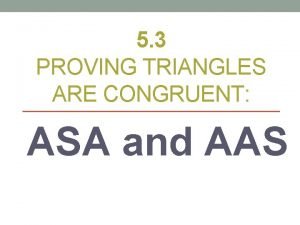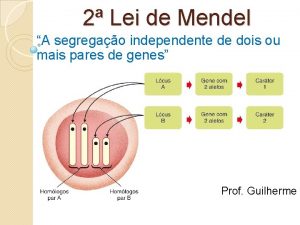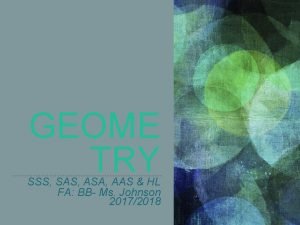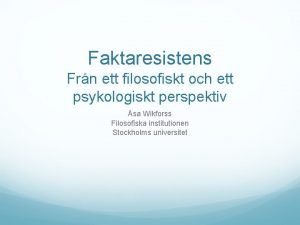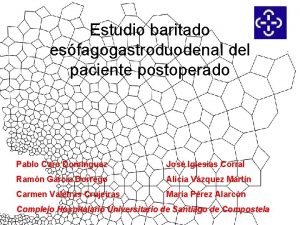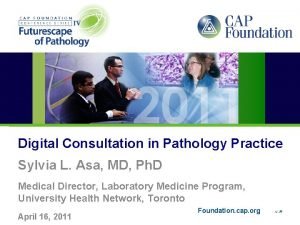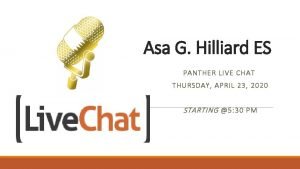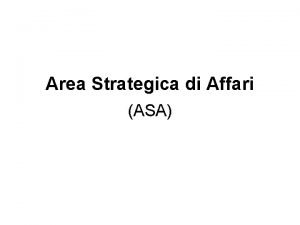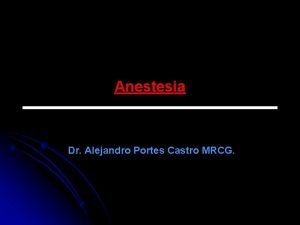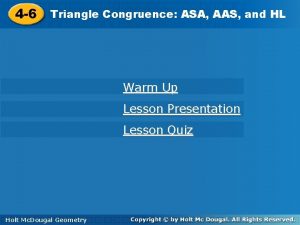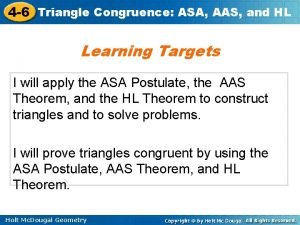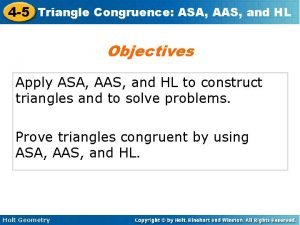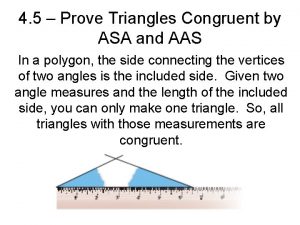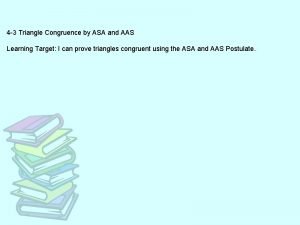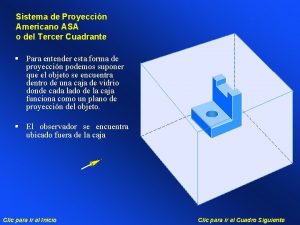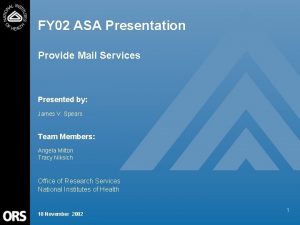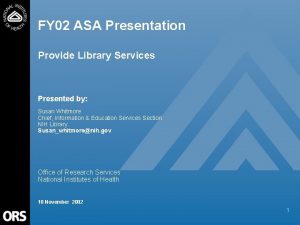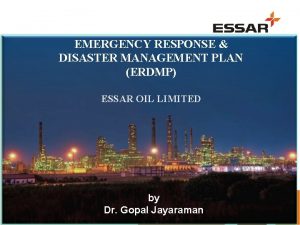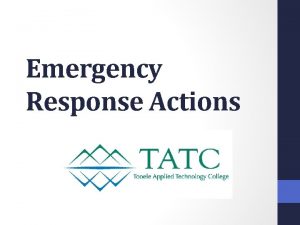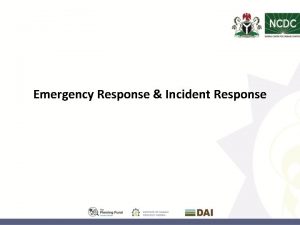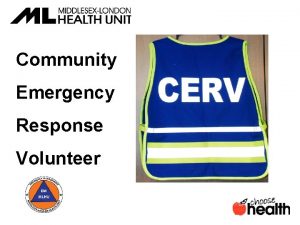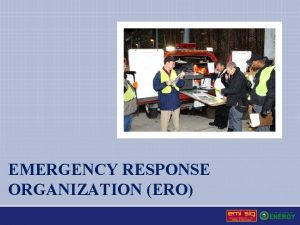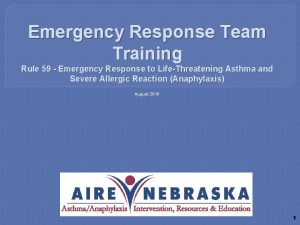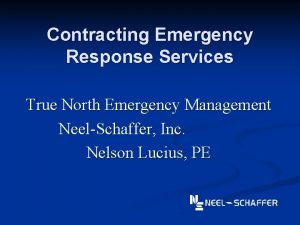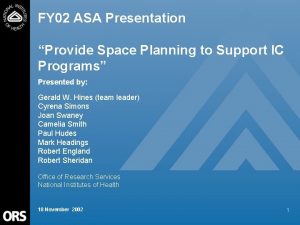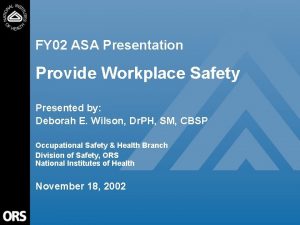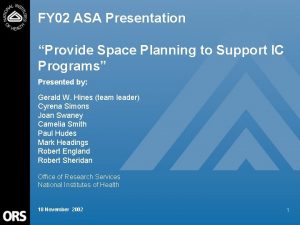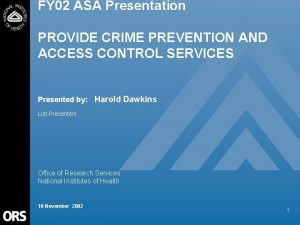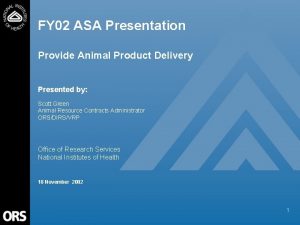FY 02 ASA Presentation Provide Emergency Response Services
























































































- Slides: 88

FY 02 ASA Presentation Provide Emergency Response Services Presented by: Assistant Chief Jonathan Mattingly Team Members: Chief Gary Hess Master Firefighter Joe D’Ambrosio Master Firefighter Paul Donaldson Master Firefighter Edward Gotthardt Master Firefighter Thomas Kellum Master Firefighter Lori Padgett Technician Michael Laven Office of Research Services National Institutes of Health 18 November 2002 1

Table of Contents Main Presentation ASA Template ………………………………. 3 Customer Perspective………………. 5 Customer Segmentation ………………… 6 Customer Satisfaction…………………. 8 Unique Customer Measures………………… 10 Internal Business Process Perspective………………… 11 Service Group Block Diagram…………………………. . 12 Conclusions from Discrete Services Deployment Flowcharts………………. 18 Process Measures………………………………. . 19 Learning and Growth Perspective……………………. 23 Conclusions from Turnover, Sick Leave, Awards, EEO/ER/ADR Data……. . 31 Analysis of Readiness Conclusions……………………… 32 Unique Learning and Growth Measures……………………. 33 Financial Perspective……………………………. . 34 Unit Cost……………………………………… 35 Asset Utilization………………………………… 37 Conclusions and Recommendations……………………. 39 Conclusions from FY 02 ASA. . ………………………… 40 Recommendations………………………………… 41 2

3

4

Customer Perspective 5

Customer Segmentation DS 1: Respond to Medical, Fire, and Hazardous Incidents. 6

Customer Segmentation DS 2: Maintain a Comprehensive Fire Extinguisher Program. 7

Customer Satisfaction FY 02 Product/Service Satisfaction Ratings 8

Customer Satisfaction FY 02 Customer Service Satisfaction Ratings 9

Types of Emergency Situations Usage of Service Based on Emergency Type 10

Internal Business Process Perspective 11

Service Group Block Diagram Provide Emergency Response Services 12

13

14

15

16

17

Conclusions from Discrete Services Deployment Flowcharts • Our Service Group completed 3 linear flowcharts for 2 discrete services • There are little to no outside processes that affect the internal flow, therefore linear flowcharts were created. Based on the data collected, and the feedback from the NIH Community, there were no deficiencies identified. FERS data is collected continuously, any future deficiencies would be identified, and corrected within. • • 18

Process Measures • List process measures for each discrete service • • DS 1: DS 2: Response Times Fire Extinguisher Inspections Completed on Schedule 19

Response Times 20

Fire Extinguisher Inspections Completed on Schedule • • Inspection Schedule is Regulation Driven JCAHO Requirements for Clinical Center NFPA 10 Requirements for Campus/Farm ALAC Requirements for Animal Care Areas • Inspections are REQUIRED to be Completed in Accordance with the Requirements • Therefore, the Inspections are Completed on Schedule, 100% of the Time 21

Incorporate Recommendations of the Service Area Review • Document Percentage of Progress • Proceed with Purchase of Ladder Truck in FY 02 Hire 10 Fire Fighters to Fully Staff the Truck Hire an Assistant Chief for Health/Safety/Training Increase Training Between NIH and Montgomery County Haz-Mat Teams Increase Command Level Meetings Between NIH, NNMC, and Montgomery County Consider adding Advanced Life Support Capabilities to the NIH Fire Department • • • 22

Learning and Growth Perspective 23

Service Group Turnover Rate (Oct 2001 - June 2002) Service Group Number 24

Average Hours of Sick Leave Used (Oct 2001 - June 2002) Service Group 14 Average Hours NIH Fire Fighters Work a 24 Hour Shift as Part of a 72 Hour Work Week, 72 Hours of Sick Leave = 3 Days In Comparison, We Should Fit Where Indicated In Red Service Group Number 25

Average Number of Awards Received Average number (Oct 2001 - June 2002) Service Group Number 26

Average Number of EEO Complaints Average Number (Oct 2001 - June 2002) Service Group Number 27

Average Number of ER Cases Average Number (Oct 2001 - June 2002) Service Group Number 28

Average Number of ADR Cases Average Number (Oct 2001 - June 2002) Service Group Number 29

Learning and Growth Data Table No EEO complaints, ER cases, or ADR cases No turnover About 2 awards for every 3 employees About 3 days of sick leave per employee 30

Summary of Service Group 14 Learning and Growth Data • • No turnover About 3 days of sick leave per employee About two awards for every 3 employees No EEO complaints, ER cases, or ADR cases 31

Analysis of Readiness Conclusions • • • The NIH Fire Department routinely conducts informal self assessments. Based on those assessments, the FERS develops strategies to improve and/or implement those findings. The 2000 SAR panel of experts validated the strategies, previously identified in the assessments. At this point, there were no new initiatives identified through the ASA. Provided that the FERS Budget Request is approved as requested, all future initiatives for the improvement of the FERS, will be initiated. 32

PO: Employee’s Education Exceeding Job Requirements PM: Percentage Above Requirement 33

Financial Perspective 34

Unit Cost Measures 35

Unit Cost Measures 36

Asset Utilization Measures • The NIH Fire Department (FERS) Consists of: • • • • 1 Fire Chief 3 Assistant Chiefs 4 Lieutenants 12 Firefighters A Recruitment in Progress to add 10 Firefighters A Recruitment in Progress to add a Program Support Assistant 1 Engine 1 Ambulance 1 Hazardous Materials Unit 1 Mass Decontamination Unit 1 Command Unit 2 Support Vehicles 1 Fire Station (New Fire Station has a March ’ 03 Completion) A Ladder Truck on Order 37

Asset Utilization Measures The assets of the Fire and Emergency Response Section, are considered a necessity to the mission of the NIH Fire Department. It would not be practical to allow others to utilize these assets. In addition, these assets must be immediately available for the purpose of responding to emergencies arising at the NIH. Therefore, the utilization of the assets are viewed as 100%, as they remain in constant use by the NIH as an emergency response resource. 38

Conclusions and Recommendations 39

Conclusions from FY 02 ASA • This process reinforced the strategies already in place, previously identified through internal assessments, and that were validated by the External Panel of Experts during the 2000 Service Area Review. • Future periodic assessments will ensure that the strategies implemented will continue to result in efficient operations, and increased customer service. 40

Recommendations • The Fire and Emergency Response Section will continue to collect, and analyze existing and future data to ensure Operational Excellence is maintained. • Continue to implement the existing strategies as previously identified. • The Fire and Emergency Response Section of the NIH will continue to develop and increase its capabilities, to meet the ever changing needs, trends, and developments within the Fire and Emergency Services for the community which we serve. 41

Appendices 42

Appendices • Include the following: • • • ORS Customer Scorecard Data Learning and Growth Data Readiness Data 2000 SAR Summary Unit Cost Data 43

FY 02 ORS Customer Scorecard Data for the Annual Self Assessments Service Group 14: Provide Emergency Response Services 16 October 2002 Summary Prepared by the Office of Quality Management (OQM) 44

Methodology • ASA Teams determined best methodology to assess customer satisfaction • FY 02 methodology reviewed by OQM • • Customer segments to be assessed • Customization of ORS Customer Scorecard instrument • Description of item to be assessed (e. g. , Service Group, Discrete Service, specific product/service) • Method of survey distribution (e. g. , email, hard copy) • Accompanying Memos/email messages • Timeline for distribution and return • Number of surveys to be distributed Upon gaining approval, ASA Teams distributed surveys to customers 45

Methodology (cont. ) • Completed surveys were returned to Emergency Response Services • Provided completed surveys to OQM • Survey data were entered into a database and analyzed • Results typically summarized at Service Group level • If sufficient number of completed surveys were returned, may be able to generate analyses for specific products/services 46

Survey Distribution Number of Surveys Distributed Provide Emergency Response Services 170 Number of Surveys Returned Provide Emergency Response Services 32 Response Rate 19% 47

Survey Respondents FY 02 Respondents by IC Note: Not all respondents answered this question. 48

Survey Respondents (cont. ) FY 02 Respondents by Location 49

Radar Chart Interpretation • Compare ratings for product/service characteristics – – • Compare ratings for customer service characteristics – – • What’s rated highest? Why? What’s rated lowest? Why? As another method to interpret your results, compare your ratings to ORS overall – – Are you above or below the ORS overall ratings? Why? 50

Radar Chart FY 02 Product/Service Satisfaction Ratings Note: The rating scale ranges from 1 - 10 where “ 1” represents Unsatisfactory and “ 10” represents Outstanding. Refer to the Data Analysis and Graphing training for advice on interpreting these results. 51

Radar Chart FY 02 Customer Service Satisfaction Ratings Note: The rating scale ranges from 1 - 10 where “ 1” represents Unsatisfactory and “ 10” represents Outstanding. Refer to the Data Analysis and Graphing training for advice on interpreting these results. 52

Scatter Diagram Interpretation • • What do customers feel is most important? What was their satisfaction on the most important dimensions? What actions can be taken to address the situation? Focus first improvement efforts on areas most important to customers with lower satisfaction ratings 53

Scatter Diagram FY 02 Customer Importance and Satisfaction Ratings Note: The Importance rating scale ranges from 1 - 10 where “ 1” represents Unimportant and “ 10” represents Important. The Satisfaction rating scale ranges from 1 - 10 where “ 1” represents Unsatisfactory and “ 10” represents Outstanding. 54

Scatter Diagram FY 02 Customer Importance and Satisfaction Ratings: A Closer Look Note: A smaller portion of the chart is shown so that the individual data points can be labeled. 55

Reviewing Comments • • • Realize comments are qualitative data and are not meant to be counted and tallied Comments provide a different type of information from your customers regarding their satisfaction Comments are NOT representative of the perceptions of all your customers • • Review them but don’t over react to an individual comment Comments are a great source for ideas on how to improve 56

What was done particularly well? • • • • Program consistently provides complete and accurate and timely documentation required for hospital's accreditation. Responsiveness to problems or questions. The fire department responds quickly and handles any small or large problem efficiently. They are always professional, polite and ask questions pertaining only to the situation. EMS team called was very efficient and knowledgeable. Rapid response. Educational classes are well taught. Relaxed manner. Carefully looks into the situation. Followed up to let me know their assessment. Good communications. 1. Response time. 2. Attention to details. Coordination of scheduled fire drills, and unscheduled fire alarm response (triggered by technical problem in our building)/ Response was fast, efficient and professional. Consistently outstanding! Suggestions were given by fire protection personnel concerning renovations that not only saved money but also time and labor. Rapid response. Serious attitude. Helpful, thoughtful consideration of problem. Problem was solved. Problem was handled immediately. 57

What was done particularly well? • • (cont. ) The professionalism of the fire department staff is impressive. They appear well trained and knowledgeable. Response to fire drills and alarms. Changing outdated fire extinguishers w/new ones. Ongoing alarm maintenance/testing. As a former critical care nurse (25 years!) I can say the EMT's were competent, compassionate and professional. I was impressed! 58

What needs to be improved? • • Nothing. Over good, no major concerns. Would recommend much higher Evaluation of Discrete Service. There are much more important things you do than Fire Exting. Would be interested in see cost data and how it is distributed to IC's. Lack of con…. . ? Poor use of English language gives low confidence in speaker. 1. Knowledge of ? ? System for ? ? 2. Should bring own decontaminant (left away) Typically, scheduled fire drills are well organized. However, in a recent drill, the new/substitute fire person coordinating the drill did not look for, or meet, the building fire coordinator, causing the re-entry of building occupants to be delayed. My experience is limited; thus the questions does not apply for my judgment. None. 59

Other Comments • • We have had only one medical experience with the EMS Fire service. So our comments are based on the one experience. Our office Has not had a problem that requires the fire department. Overall, NIH Emergency Personnel are top notch and perform their jobs in an excellent and professional manner. It would be desirable to have a web based request form for the scheduling of burn permits. User would schedule time/date/location to meet inspector in advance. Thanks for being there when needed. I commend your unit and dedication to a very difficult job. Very professional and friendly help was provided. Our nursing unit does. Have not had to call in a fire or suspicious odor report. 60

Summarizing Your Customer Scorecard Data • Make conclusions based on graphs and comments – – – • Summarize what you learned from the data Highlight where you excel Diagnose any issues shown by the data If appropriate, generate potential actions based on what you have learned from the data – – – Can you make changes to address what you learned from data? How might you implement those actions? State actions in terms of recommendations 61

Summarizing Your Customer Scorecard Data (cont. ) • Interpret ORS Customer Scorecard data in terms of other ASA data • • • Internal Business Process measures Learning and Growth data Financial measures Does the customer satisfaction data, when compared to data in other perspectives, show potential relationships? From reviewing your data, what could be done to improve your customers’ satisfaction? 62

Minimum Actions Required by Team • • Provide feedback to all those you sent a survey Format can vary as desired • • • Email this summary Prepare short list of bullets summarizing findings Prepare write up of results and conclusions Keep it simple but emphasize you did receive and analyze customers’ feedback Will help with future customer survey efforts if you indicate actions planned based on the survey findings 63

FY 02 Learning and Growth (L&G) Data for the Annual Self Assessments Service Group 14: Provide Emergency Response Services 26 September 2002 Summary Prepared by the Office of Quality Management 64

Methodology • All data represent occurrences from Oct 2001 - June 2002 • • ORS Human Resources (HR) provided data on: • • Data analyzed covered period between October 1 st and end of June to provide time to analyze and present the data Turnover Sick leave Awards HR data stored in NIH databases by Standard Administrative Codes (SACs) • • • Developed cross-reference of ORS Service Groups to SACs Almost all SACs assigned to Service Groups Some Service Groups have identical SACs • In this case, two Service Groups will receive same set of data 65

Methodology (cont. ) • Also obtained data from: • Equal Employment Opportunity (EEO) • • Employee Relations (ER) • • Number of EEO complaints Number of ER cases Alternative Dispute Resolution (ADR) • ADR cases 66

Interpreting Your Data • FY 02 is the first time L&G data were collected analyzed • • Interpret data in terms of other ASA data • • • Compare your Service Group relative to the other ORS Service Groups What are all the L&G indicators telling you? In the future your group should compare itself to its own Service Group data over time Customer satisfaction ratings Process measures Financial measures Does the L&G data, when compared to data in other perspectives, show potential relationship (could L&G be contributing to customer satisfaction results)? From reviewing your Service Group’s L&G data, what could be done to improve Quality of Work Life (QOWL)? 67

Service Group Turnover Rate • Calculated as the number of separations for a Service Group / Population of Service Group • Separations defined as: • • Retirements (separation codes 3010, 3022) Resignations (separation codes 3120, 3170) Removals (separation codes 3300) Terminations (separation codes 3520, 3550, 3570) Promotions to new organization (separation codes 7020) Reassignments (separation code 7210) Note that transfers/promotions within ORS Divisions/Offices are not captured by the NIH database 68

Service Group Turnover Rate (cont. ) • Calculation of Service Group population was needed since number of employees changes over time • Population for Service Group was estimated based on average of employee count at three snapshots in time (Nov 2001, Feb 2002, June 2002) 69

Service Group Turnover Rate (Oct 2001 - June 2002) Service Group Number 70

Average Hours of Sick Leave Used • Calculated as the total number of sick leave hours used for a Service Group / Population of Service Group 71

Average Hours of Sick Leave Used Average Hours (Oct 2001 - June 2002) Service Group Number 72

Average Number of Awards Received • • Calculated as the total number of awards received / Population of Service Group Includes both monetary and non-monetary awards • • • Cash awards QSIs Time-off Honorary Customer Service 73

Average Number of Awards Received Average number (Oct 2001 - June 2002) Service Group Number 74

Average Number of EEO Complaints • Calculated the total number of EEO complaints for a Service Group / Population of Service Group 75

Average Number of EEO Complaints Average Number (Oct 2001 - June 2002) Service Group Number 76

Average Number of ER Cases • • Calculated the total number of ER cases for a Service Group / Population of Service Group Case is defined as any contact with ER Office where an action occurs (e. g. , Letter is prepared) 77

Average Number of ER Cases Average Number (Oct 2001 - June 2002) Service Group Number 78

Average Number of ADR Cases • • Calculated the number of ADR cases for a Service Group / Population of Service Group Case is initiated when person contacts ADR 79

Average Number of ADR Cases Average Number (Oct 2001 - June 2002) Service Group Number 80

Learning and Growth Data Table No EEO complaints, ER cases, or ADR cases No turnover About 2 awards for every 3 employees About six (12 -hour) periods of sick leave per employee 81

Summary of Service Group 14 Learning and Growth Data • • No turnover About six (12 -hour) periods of sick leave per employee About two awards for every 3 employees No EEO complaints, ER cases, or ADR cases 82

Analysis of Readiness Fire and Emergency Response Section ASA Readiness Questions What are the right mix of skills and abilities needed to carry out the mission this service group? Fire Department staff must maintain the knowledge, skills and abilities (KSA’s) to respond to all types of emergencies including; fires, emergency medical, technical rescue and hazardous materials releases. These KSA’s were identified in 1996, new Master Firefighter positions were created and the other Position Descriptions were upgraded to reflect anticipated future needs. In addition, performance standards were developed and are continually updated for each of these positions. The training levels of all FERS staff remains in compliance with national fire service standards and the specialized training requirements inherent to emergency response to a biomedical facility. Will the service group have sufficient numbers of people, with the right skills and abilities to carry out its mission in the next three years? If the projected budget requests are fully funded, the Fire Department will have sufficient numbers of people, with the right skills and abilities to carry out its mission, provided that no unforseen catastrophic incidents occur. What are going to be the training needs of the employees and contractors employed in this service group in the next two to three years? Individual training plans have been developed for each FERS staff. These plans are regularly updated to reflect changes in national standards and mission requirements. What will be the right tools or materials needed to carry out the mission of this service group in the next three years? The Fire Department currently has or is in the process of procuring most of the tools and materials needed to carry out the mission. The materials must be replaced as they are used for emergency response activities and tools must be upgraded or replaced as new technologies are developed. 83

Analysis of Readiness Fire and Emergency Response Section ASA Readiness Questions (Continued) Does the service group have the right quantity of tools or materials needed to carry out its mission in the next three years? Yes, provided we are permitted to continue to replace used materials and upgrade or replace outdated equipment as technology changes. What are the anticipated implications of not obtaining the right mix of skills and abilities, or tools and materials in meeting service or mission expectations? The NIH Fire Department is responsible for all emergency response activities as noted above. Unlike large departments, which typically have specialty teams trained for specific response services, all of the NIH Firefighters must be prepared and equipped to respond to these different types of incidents. Not obtaining the right mix of skills and abilities, or tools and materials would have an adverse impact on all aspects of the Emergency Response Program including longer response times, a decrease in customer satisfaction, the inability to respond to multiple calls and a loss of technical expertise needed to respond to hazardous materials and technical rescue incidents. Summary Over the past decade, the NIH Fire Department routinely conducted informal self assessments. As a result of those assessments, recommendations were made and plans were implemented to improve the Fire Departments emergency response program including, the addition of technical rescue capability, improvements in hazardous materials response capability and response to terrorist incidents. A Service Area Review of the NIH Fire Department was conducted in 2000 and a panel of Fire Service Experts evaluated the operational aspects of the Department. The Panel of Experts concluded that the NIH Fire Department was providing outstanding services to the NIH community at that time and made several recommendations to ensure the same level of services would be provided in the future. The NIH Fire Department is in the process of implementing those recommendations, including additional staffing and the purchase of a Ladder Truck. Based on the findings of the 2000 Service Area Review and the 2002 Annual Self Assessment, the NIH Fire Department will not require any major improvements in the operational infrastructure, other than those which have already been identified and are in the process of being implemented. 84

2000 SAR Status of Recommendations of the Service Area Review PANEL OF EXPERTS RECOMMENDATIONS AND CONCLUSIONS Based on the data and information collected, the customer service surveys, the benchmarking surveys, and after a comprehensive review of all pertinent aspects of the NIH Fire Department and its operations, the Panel of Experts offered the following conclusions and recommendations: Conclusions • The NIH Fire Department is providing outstanding emergency and non-emergency services to the NIH community, especially considering existing staffing levels. There are no additional services that should be considered. Of special note are the comprehensive fire extinguisher program (approximately 4, 000 extinguishers in service) and the fire department involvement in the massive construction and renovation programs at the Bethesda campus. • The NIH Fire Department is in compliance with all applicable national codes, standards, regulations and laws relating to fire department operations. The only possible exception is that the NIH Fire Department does not presently meet all the requirements of the National Fire Protection Association (NFPA) 1500, “Standard on Fire Department Occupational Safety and Health Program”; however, to be in compliance with NFPA 1500, a fire department must only identify where deficiencies exist and then develop a corrective action plan and a timeline under which the requirements will be met, which the NIH Fire Department has done. The two main concerns expressed by the Panel were low staffing levels and the lack of a dedicated Fire Department Safety Officer. Nonetheless, the Panel of Experts concluded that the NIH Fire Department had generally achieved the same level of NFPA 1500 compliance as the other Departments represented on the Panel. The Panel stated that the appropriate plans are established for meeting all associated compliance codes and standards. It should be noted that many of the NIH deficiencies will be corrected when additional positions are provided in the FY 02 Budget and when the new Fire Station is constructed. • The Panel concluded that staffing is inadequate for the level and comprehensiveness of services provided. They recommended the addition of the positions requested for the new fire truck in FY 02, and that the Department also hire a dedicated Fire Department Safety Officer at an Assistant Chief level, working a 56 -hour week to handle Safety Officer duties, training and to assist the Fire Chief in administrative tasks. • The Panel of Experts indicated that the training and personnel requirements are totally “on target” for the comprehensive level of services provided and suggested that the NIH Fire Department continue in the present direction. • The present apparatus and equipment are considered adequate in terms of design and functionality. Of special note is the NIH Fire Department Haz. Mat Unit and the Mass Decontamination Unit. The latter was described as the best seen in the area. The Panel again recommended, because of the call load, the number of simultaneous incidents, anticipated growth of the NIH, the number of high rise buildings on campus, and the lack of a “reserve” Pumper that the NIH procure the Pumper/Ladder Truck in FY 02 and hire the positions to fully staff the truck at all times. The Panel felt that the addition of a fully staffed Truck Company to the NIH Fire Department is both prudent and necessary. 85

2000 SAR (Continued) • The Panel felt that the present organization of the NIH Fire Department is optimal, considering the constraints inherent in utilizing two 24 -hour shifts; although they reiterated their recommendation that a Fire Department Safety/Training Officer be hired. • The response times for the NIH Fire Department were considered excellent, and well below the accepted national standard. Improvement on those times would be impossible to achieve. • The overall quality and comprehensiveness of services provided by the NIH Fire Department were considered outstanding. This is further demonstrated by the results of the Customer Service Survey which the Panel of Experts felt was extraordinary. The Panel commented that they wished their “consumers” were as satisfied as the NIH community appears to be with the NIH Fire Department. The Panel especially noted that the completion of the Mass Decontamination Unit has further enhanced an already noteworthy hazardous materials response capability in the NIH Fire Department. SERVICE AREA REVIEW SUMMARY The objectives of the Service Area Review were to address five basic issues: 1) identify the needs of the NIH community with regard to fire protection; 2) assess whether these needs are being adequately met at the present time; 3) determine if improvements relating to fire department are required and, if so, what can be done to improve services; 4) determine if appropriate steps are being taken to monitor and, if required, improve performance; and 5) compare the quality and level of services provided by the NIH Fire Department to other fire departments similarly situated. Based on the results presented in this report, especially considering the Benchmarking Study, the Customer Service Surveys and the extensive review by the Panel of Experts, it has been determined that: . The fire protection needs of the NIH community have been identified. . The NIH Fire Department meets those needs in an outstanding fashion at this time. . Operational improvements in the NIH Fire Department are not needed at this time; however, it is strongly recommended that additional staffing and an additional piece of apparatus are needed to continue to adequately protect NIH community. . Adequate steps are continually being taken to monitor the performance of the NIH Fire Department. . The quality and quantity of emergency and non-emergency services provided by the NIH Fire Department clearly exceed the services provided by similarly situated Fire Departments that were “benchmarked” against in the review. 86

2000 SAR (Continued) Current Status of the SAR Recommendations Proceed with the purchase of a Ladder Truck (Quint) in FY 02 and hire the ten positions required to fully staff the Truck. Funding was not approved in FY 02. The Ladder Truck has been ordered and the a recruitment process is underway to fill the 10 positions. Provide a position for an Assistant Chief level 56 -hour week Fire Department Safety/Training Officer to meet the requirements of NFPA 1500, “Standard on Fire Department Occupational Safety and Health Program”, as well as to conduct all in-house training consistently, coordinate all outside training, and to assist the Fire Chief in the Department administrative functions. This would allow for more than one person to be on duty each weekday, Monday through Friday, and to ensure consistency in operations when the Fire Chief is on leave, travel or training. Completed The NIH and Montgomery County Hazardous Materials Teams should train together more frequently. The NIH and Montgomery County Hazardous Materials Teams routinely attended the same formal training sessions and drill together at least bimonthly. There should be more frequent Command Level meetings between the NIH, Montgomery County and the National Naval Medical Center Fire Departments, perhaps on a quarterly basis. Formal Command Level meetings are held on the average twice a year and meetings are routinely held whenever issues arise between the parties. Consider, after extensive evaluation, the possibility of adding an “Advanced Life Support” (ALS) capability to the NIH Fire Department. It was recognized that numerous logistic and legal considerations would be involved in implementing an ALS program. Adding an Advanced Life Support (ALS) capability to the NIH Fire Department was considered. The decision was made to purchase an Automatic External Defibrillator and continue utilizing Mutual Aid from Montgomery County for ALS at this time. 87

Unit Cost Measures 88
 The importance of training
The importance of training Emergency response plan meaning
Emergency response plan meaning Blue section of erg
Blue section of erg Ercp emergency response
Ercp emergency response Ecrv
Ecrv Sing cert
Sing cert Utm emergency response plan
Utm emergency response plan 29 cfr 1910 120
29 cfr 1910 120 Missouri emergency response commission
Missouri emergency response commission Blue section of erg
Blue section of erg Emergency disaster tactical response
Emergency disaster tactical response Erg 2008
Erg 2008 Walmart emergency management
Walmart emergency management Emergency response plan
Emergency response plan Emergency response tool
Emergency response tool Standards in preparing guest clothes and shoes
Standards in preparing guest clothes and shoes What types of housekeeping requests guests make
What types of housekeeping requests guests make Provide reception services
Provide reception services Emergency medicine case presentation
Emergency medicine case presentation Answer site
Answer site Natural response and forced response
Natural response and forced response Natural and forced response
Natural and forced response Primary immune response and secondary immune response
Primary immune response and secondary immune response Metropolitan fire and emergency services board
Metropolitan fire and emergency services board National emergency services academy
National emergency services academy Onsite emergency plan
Onsite emergency plan Law enforcement video association
Law enforcement video association Presentation and data response grade 12
Presentation and data response grade 12 5cm labor
5cm labor Leopold maneuver
Leopold maneuver Managed services offering ppt
Managed services offering ppt Professional services presentation
Professional services presentation Difference between intserv and diffserv
Difference between intserv and diffserv Wake county human services community services center
Wake county human services community services center Right triangle congruence theorems
Right triangle congruence theorems Lesson 4-4 proving triangles congruent-sss sas
Lesson 4-4 proving triangles congruent-sss sas Aas theorem
Aas theorem Asa postulate example
Asa postulate example Triangle congruence by asa and aas quiz part 1
Triangle congruence by asa and aas quiz part 1 Asa nerve
Asa nerve Asa de henle funcion
Asa de henle funcion Raag asa
Raag asa Sara pe deal teme si motive
Sara pe deal teme si motive Distribuir publicidade telepizza
Distribuir publicidade telepizza Sss sas asa aas
Sss sas asa aas Vertical angle congruence theorem
Vertical angle congruence theorem Npo guidelines asa
Npo guidelines asa Npo guidelines asa
Npo guidelines asa Asa 2
Asa 2 Asa grading
Asa grading Direct laryngoscopy view
Direct laryngoscopy view Riikka asa
Riikka asa Cisco asa configuration audit tool
Cisco asa configuration audit tool Asa clasificacion
Asa clasificacion Asa medicina
Asa medicina N.buccalis
N.buccalis Score asa
Score asa Duo cisco asa
Duo cisco asa Asa nat 설정
Asa nat 설정 Reflejos polisinapticos ejemplos
Reflejos polisinapticos ejemplos Clasificacion asa
Clasificacion asa Classificação asa anestesia
Classificação asa anestesia Asa format header
Asa format header Asa role
Asa role Riesgo asa
Riesgo asa Asa classification
Asa classification Asa classification age
Asa classification age How to prove triangles are congruent
How to prove triangles are congruent Asa congruence
Asa congruence Ufpa na drosophila melanogaster a cor do corpo
Ufpa na drosophila melanogaster a cor do corpo O isuse domnul meu
O isuse domnul meu Asa uidai
Asa uidai Ahmet uygun gata
Ahmet uygun gata Introduction to bookkeeping and accountancy exercise
Introduction to bookkeeping and accountancy exercise What is sss sas asa aas and hl
What is sss sas asa aas and hl Faktapolarisering
Faktapolarisering Sindrome de asa aferente
Sindrome de asa aferente Stressless marketing
Stressless marketing Sylvia l. asa
Sylvia l. asa Asa g hilliard elementary
Asa g hilliard elementary Area strategica d'affari
Area strategica d'affari Midazolam nome commerciale
Midazolam nome commerciale 4-6 triangle congruence asa aas and hl answers
4-6 triangle congruence asa aas and hl answers Aas triangle
Aas triangle Hl
Hl 4-5 proving triangles congruent
4-5 proving triangles congruent 4-4 proving triangles congruent asa aas
4-4 proving triangles congruent asa aas Lesson 4-3 triangle congruence by asa and aas
Lesson 4-3 triangle congruence by asa and aas Sistema asa americano
Sistema asa americano
